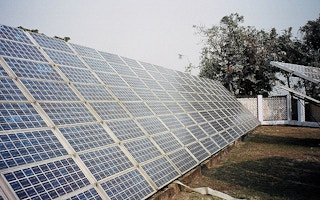Financing clean energy infrastructure was high on the agenda at the BRICS Leaders’ Summit in Goa last month. But recent research has found that the BRICS countries – Brazil, Russia, India, China and South Africa – face a USD 51 billion annual funding shortfall to meet projected demand for new clean energy.
The study, by the Institute for Energy Economics and Financial Analysis (IEEFA), looks at the national renewable energy targets of BRICS countries and also the national estimates for the total required investment to meet them. BRICS countries have a collective renewable energy target of approximately 1250 gigawatts between 2020 and 2030, at a total estimated cost of USD 975 billion (6.6 trillion yuan).
The majority of the required investment (USD 622 billion) will be in China, although major investments will also be needed in India (USD 157bn) and Brazil (USD 120bn).
BRICS lead in renewables investment
Despite the USD 51 billion shortfall, four of the five BRICS countries rank in the global top ten for renewables investment. In 2015, about 40 per cent of global investment in clean energy was in China, India, Brazil or South Africa. Led by China, investment in clean energy in emerging and developing countries was ahead of developed countries for the first time.
“
Curtailment, which is a symptom of an ineffective policy framework, is taking a major toll on renewable energy investments.
Li Shuo, senior climate policy adviser, Greenpeace East Asia
Annual investment
To meet the energy investment targets, BRICS countries need to cumulatively spend approximately USD 177 billion (1.2 trillion yuan) annually. But at the moment, they’re a long way off. China accounts for the majority of low carbon investment with US$102.9 billion annually. Excluding China, the other four BRICS countries need to invest US$52 billion annually, but in 2015 they invested only USD 23 billion – less than half what they said they would.
Investment barriers
China is investing significantly more than other BRICS countries but policy challenges and high levels of renewables curtailment – when available energy is not dispatched to the grid – demonstrate the challenge of scaling-up green energy investment.
“Curtailment, which is a symptom of an ineffective policy framework, is taking a major toll on renewable energy investments,” said Li Shuo, senior climate policy adviser at Greenpeace East Asia. He added: “Heavy curtailment and decreasing utilisation hours for wind is becoming evident in dampening investor enthusiasm.” So despite a significant increase in China of wind capacity in the first three quarters of 2016 to 140 gigawatts, total investment in the technology dropped by 29 per cent.
On the plus side, as wind and solar power prices fall quickly, China could meet its 2020 renewable energy targets more cheaply than expected.
In Russia, Western sanctions and low oil and gas prices have created tough economic conditions that have stymied investor interest in clean energy. The state’s dependence on the oil and gas sectors for tax revenues means that there is limited political will to develop clean energy.
Russia’s goal of 4.5 per cent renewable electricity (excluding hydropower) by 2020 has already been moved back to 2024. With limited political commitment and an unattractive investment environment, it will be extremely challenging for Russia to fill the USD 10 billion annual investment gap identified by IEEFA.
Brazil’s economy is also struggling but despite a decrease in projected power demand, the Brazilian Development Bank (BNDES) has signalled that it will continue to fund renewable energy projects such as wind and solar PV, stop investment in coal and limit loans for natural gas and hydro, according to Roberto Kishinami, power portfolio coordinator at the Institute for Climate and Society (ICS).
Kishinami expects renewables to continue to gain a larger share of Brazil’s energy supply. “Driven by the decrease at unit investment cost and increased finance support from BNDES, there is an expected growth in the share of wind power plants (currently 6.5 per cent of installed capacity), followed by PV and large biomass power plants,” he said.
Blended finance
Although a number of BRICS countries are facing challenging economic circumstances, the extent to which this translates to additional risk for investors will depend on the availability of public finance for clean energy investment. IEEFA note the importance of blended finance mechanisms to help fill the gap in renewable energy investment.
According to the World Economic Forum, the current global capital market is USD 218 trillion. In 2015, approximately USD 156 billion was invested in renewable energy infrastructure in developing countries. Blended finance mechanisms could help direct private investments towards filling the renewable energy investment gap in BRICS countries.
This story was published with permission from The Third Pole. Read the full story.










